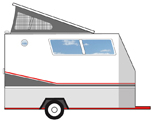StandUpGuy's trailer ride
65 posts
• Page 3 of 5 • 1, 2, 3, 4, 5
Re: StandUpGuy's trailer ride
From your photo; the trailer is pretty close to level.
Placing the nose of the trailer below level won't help, and may create new instability issues.
You could gain an inch of additional height by changing the spring shackles for longer ones.
Drop hitches come in two inch increments, so changing to a straight bar may put you too low.
In the end, an inch too high or too low should not cause instability.
If it is already on the edge, it might help, but correcting the real problem is a better direction to take.
If it is still unstable, I would bet money that the axle is too far forward.
Adding weight to the front may still help, but if not, adding length to the tongue will, in effect, push the axle further back.
We are all talking about adding weight to the front, which is good, but is there weight behind the axle that can be removed?
Rob
Placing the nose of the trailer below level won't help, and may create new instability issues.
You could gain an inch of additional height by changing the spring shackles for longer ones.
Drop hitches come in two inch increments, so changing to a straight bar may put you too low.
In the end, an inch too high or too low should not cause instability.
If it is already on the edge, it might help, but correcting the real problem is a better direction to take.
If it is still unstable, I would bet money that the axle is too far forward.
Adding weight to the front may still help, but if not, adding length to the tongue will, in effect, push the axle further back.
We are all talking about adding weight to the front, which is good, but is there weight behind the axle that can be removed?
Rob
Waiting for "someday" will leave you on your deathbed wondering why you didn't just rearrange your priorities and enjoy the time you had, instead of waiting for a "better" time to come along...
-

48Rob - Super Lifetime Member
- Posts: 3882
- Images: 4
- Joined: Thu Nov 17, 2005 6:47 pm
- Location: Central Illinois
Re: StandUpGuy's trailer ride
48Rob wrote:From your photo; the trailer is pretty close to level.
Placing the nose of the trailer below level won't help, and may create new instability issues.
You could gain an inch of additional height by changing the spring shackles for longer ones.
Drop hitches come in two inch increments, so changing to a straight bar may put you too low.
In the end, an inch too high or too low should not cause instability.
If it is already on the edge, it might help, but correcting the real problem is a better direction to take.
If it is still unstable, I would bet money that the axle is too far forward.
Adding weight to the front may still help, but if not, adding length to the tongue will, in effect, push the axle further back.
We are all talking about adding weight to the front, which is good, but is there weight behind the axle that can be removed?
Rob
Really my biggest killer was the toilet. I had planned on the tolet being on the axle side of hte bathroom for a couple of reasons. The main plumbing is on that side and would have been much easeier to plumb than putting the toilet all the way in the rear as I did. I knew that I was putting a heavy item all the way to the back and that was not my plan. But as I had it the trailer from would not have allowed for a drop down shower pan facing that way so I reversered it. I also obtained a toilet from Craigslist great deal but it is a top of the line porcelean toilet and very heavy. So that is strike two. everything else of any weight is directly over the axel or in front of it. Those items being a mini fridge in a cabinet built in and a microwave not very heavy and actually right over the axel as is the fridge. The AC unit I removed and placed all the way in the nose to bring weight forward.
I went from 72 lbs tongue weight yesterday to 145 lbs today with added items in the nose. The ride was greatly improved of course. At higher speeds there is no bucking on modest bumps. I have not hit anything significant at higher speeds yet. I only have seen the bucking at all if I am going 20-30 and hit big dips. Really it seems to me like it is riding pretty well now. I think my nose is up very slightly and perhaps if I drop it a little and add a little more weight forward perhaps it will ride even better. I have a 4" rise for my hitch currently and perhaps I should get a 3" to drop it down but I am really interested in your larger shackles bit for a little extra ground clearance. Would they have these at an auto parts store? Same as a car?
-

StandUpGuy - 1000 Club

- Posts: 1090
- Images: 52
- Joined: Sun Mar 27, 2011 6:15 pm

 How the trailer is packed can have a major effect!
How the trailer is packed can have a major effect!

